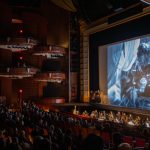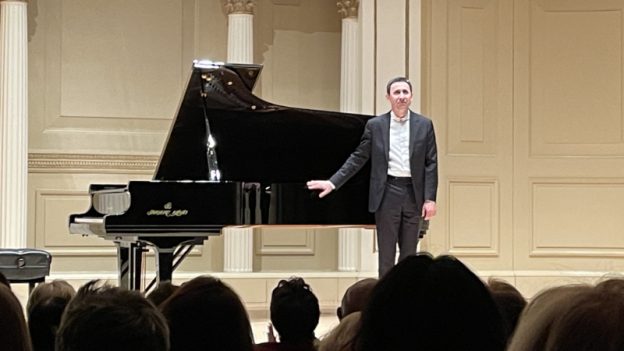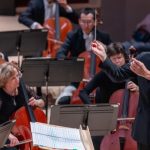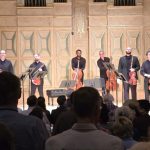November 6, 2025
Weill Recital Hall, Carnegie Hall
New York, New York – USA
Alexander Kobrin, piano.
Joseph HAYDN: Andante and Variations in F minor
Franz SCHUBERT: Four Impromptus (D. 899)
Robert SCHUMANN: Arabeske, Op. 18
Robert SCHUMANN: Kreisleriana, Op. 16
Ben Gambuzza | 10 NOV 2025
There are virtuosic pianists and there are poetic pianists. The former hit all the right notes and play really fast and play the music well; the latter sometimes miss notes and gravitate toward slower music and seem to create the composition in real time, letting it flow out of them, paying attention to each and every note, relishing the silences. A lot of pianists are both. Today, it’s Yunchan Lim. Yesterday, it was, say, Michelangeli. But some are one or the other, like Artur Schnabel (1882-1951).
The first to record all of the Beethoven sonatas, Schnabel is today remembered for sensitive and studied interpretations of Schubert and Brahms rather than for flashy, crowd-pleasing performances of Liszt and Chopin. That was no accident. According to his pupil Konrad Wolff, in his book The Teaching of Artur Schnabel, Schnabel’s philosophy of playing emphasized making the entire performance of a piece sound like “one slow exhalation” after taking a deep breath. He also believed in the entitlement of the performer to take risks, or, in his words, “Safety last.” To Schnabel, the composition, like a poem passed down through oral tradition, must be recited, not played, and carefully embellished with the controlled eccentricities of the interpreter.
Alexander Kobrin, who won the Cliburn Competition in 2005, is a poetic pianist. Thursday evening, as the opener for the tenth season of the Key Pianists Concert Series, he played his first solo recital at Carnegie’s Weill Recital Hall in six years. As he sank into Haydn’s Andante and Variations in F minor, I sank into my seat.
Kobrin’s free right hand and steady left-hand accompaniment made me doubt that I was listening to Haydn. Was this a Chopin prelude? I don’t usually think of Haydn as “enigmatic,” but Kobrin added mystery to this composer who is often too quick to show his cards. Kobrin’s pedaling was faint. As a result, his ornaments and runs were the perfect mix of succulent and dry, leggiero, the notes like confetti, sprinkled with mild abandon. His trills were uneven but had character. His pushing and pulling of the tempo moved me to the edge of my seat. Even in his minor-key works, Haydn can be playful, and Kobrin didn’t let us forget it. There was dark humor in the rests. Kobrin made Haydn his.
Schubert seemed to be a little harder for Kobrin to mold to his liking. His one major problem Thursday evening was with triplets, which form the backbone of three of the composer’s four Impromptus. Whether Schubert employs triplets as driving accompaniment in the first, roving melody in the second, or atmospheric bass in the third, they are ever-present and very exposed. (In the fourth Impromptu, the difficulty lies in catching the repeated note in the sixteenth-note quadruplets in the right hand; if you don’t catch it, the figures will become bizarre triplets.)
In each Impromptu, Schubert’s triplets form a fabric of perpetual motion which, if played around with too much, will unravel. When Kobrin brought to Schubert the same rhythmic fluidity he deployed in Haydn, his triplets were too free. Some sounded like duplets, as he often rushed to the next figure and ignored the third note. After a bungled chord in the second Impromptu, he scampered to finish and used too much pedal, blurring Schubert’s pearly tones into a smear of charcoal.
Kobrin recovered his composure in the third Impromptu, whose last chord he played with an emphasis on the fifth—a confounding but convincing touch. In the fourth, Kobrin powered through a ringing cellphone in the audience. His inconsistency in the right hand made me think he was either distracted or should stick to playing pieces that allow for greater freedom.
But after intermission, Kobrin-the-poet returned for Schumann’s Arabeske. I felt as though I was listening to Schumann himself dictate a letter to his beloved Clara, as Kobrin’s freedom found a perfect home in the composer’s floating phrases. Here, Kobrin came closest to heeding Schnabel’s call for playing like a slow exhale.
I found myself holding my breath in Kobrin’s interpretation of Schumann’s Kreisleriana. His fast-note messiness returned in the wild Florestan passages, but it sort of worked. The Kreisleriana should be a little messy. Kobrin’s reflective power returned, too, in those passages characteristic of the contemplative Eusebius. What sounds like an allusion to “Silent Night” (composed by Franz Xaver Gruber, an Austrian, in 1818) came through in Kobrin’s hands like a dream.
As Kobrin played Chopin’s Mazurka, Op. 24, No. 1 as an encore, I desperately wanted to hear the Haydn again. Schubert and Schumann are naturally poetic. Their music lends itself to dreaming and whimsy. Haydn must be coaxed into poetry. I hope it doesn’t take six more years to once again hear Kobrin reveal the unplumbed depths of a composer we thought we knew. ■
EXTERNAL LINKS:
- Alexander Kobrin: alexkobrin.com

Read more by Ben Gambuzza.
RECENT POSTS
 The Atlanta Opera conjures a night of enchantment as Glass’ score reawakens Cocteau’s ‘La Belle et la Bête’ • 20 Nov 2025
The Atlanta Opera conjures a night of enchantment as Glass’ score reawakens Cocteau’s ‘La Belle et la Bête’ • 20 Nov 2025 Jan Lisiecki on discipline, performance psychology, and programming for his Spivey Hall recital • 17 Nov 2025
Jan Lisiecki on discipline, performance psychology, and programming for his Spivey Hall recital • 17 Nov 2025




.png)